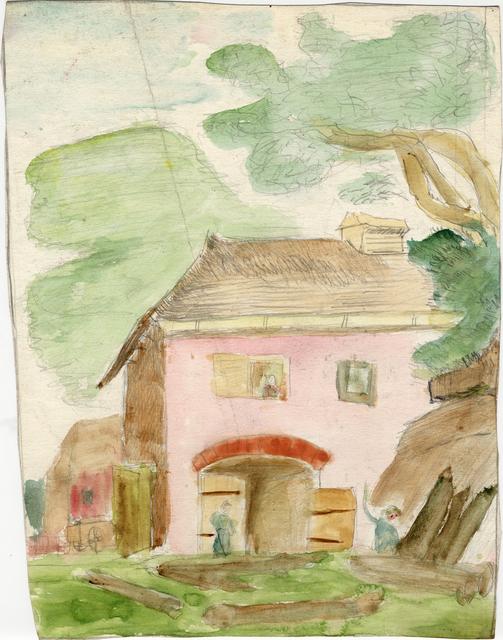In 1978, Sir John Rothenstein, for nearly 30 years Director of the Tate Gallery, London, called Dora Carrington “the most neglected serious painter of her time” [1]. That is no longer the case. In 1995, she was the subject of a major retrospective exhibition at the Barbican Art Gallery in London. That same year, the film Carrington was released, with Emma Thompson as the artist and Jonathan Pryce as Lytton Strachey. Gretchen Holbrook Gerzina’s Carrington: A Life appeared in 1989; and Jane Hill’s The Art of Dora Carrington was published in 1994.
Nevertheless, perhaps it is still for her dramatic life and complex relationships that Carrington is best known. Possessed of a remarkable personal fascination, she seems to have cast a spell on those around her. She figures in a number of novels, among them D.H. Lawrence’s Women in Love (as Minette Darrington); Wyndham Lewis’ The Apes of God (as Betty Blythe); Rosamund Lehmann’s The Weather in the Streets (as Anna Corey); and Aldous Huxley’s Chrome Yellow (as Mary Bracegirdle).
Born in Hereford in 1893 into a relatively conventional family, Carrington entered the Slade School in London in 1910, at the age of 17. In her four years there, she won prizes and scholarships, cropped her hair, permanently dropped her first name of Dora, and formed a number of important friendships, chief among them that with Mark Gertler, with whom she carried on a tempestuous love affair for a dozen years.
DORA CARRINGTON (1893 - 1932)
Pink Barn
Watercolor and pencil on paper; pencil and crayon on verso, 9 5/16 x 7 1/8 inches
Inscribed (in pencil, on verso, on crate): [illeg]/ S.C. FRANIE/ MEWROKE/ 25/ NEW/ YORK
Executed about 1901
DLA-4935
In 1915, Carrington entered the world of Bloomsbury when Gertler took her to Lady Ottoline Morrell’s Garsington, where she became a frequent visitor. There she encountered Leonard and Virginia Woolf and, later that year, while staying with the Woolfs at Asheham, she met Lytton Strachey, with whom she fell quickly and irrevocably in love.
Eminent Victorians was published in 1918, bringing instant fame to Strachey. The year before, he and Carrington had set up house together at Tidmarsh Mill in Berkshire. They remained together for the rest of their lives, moving to Ham Spray, Wiltshire, in 1924.
Carrington and Strachey lived together in what was essentially a marriage, emotionally if not legally. Their situation was complicated by Lytton’s homosexuality and by the multiple and overlapping affairs in which both engaged. For some years, Carrington with difficulty balanced her relationships with Strachey and with the violently jealous Gertler. Among her other significant affairs were those with the writer Gerald Brenan and with Ralph Partridge, with whom Lytton was also in love. In 1921, Carrington married Partridge, who joined the ménage first at Tidmarsh and then at Ham Spray, often with Frances Marshall whom he was later to marry.
In a life filled with visitors and travel, Carrington continued to paint and to draw, though she exhibited comparatively seldom and was reluctant to part with her pictures. Her famous 1916 painting of Lytton Strachey reading and her commissioned 1920 portrait of Lytton’s mother, Lady Strachey, are now both at the National Portrait Gallery, London; and her 1921 Farm at Watendlath and her 1924 Spanish Landscape with Mountains are at the Tate.
Carrington also did a significant number of decorative works, many of which have not survived. They included book jackets for the Woolfs’ Hogarth Press; bookplates for Lytton and for St John Hutchinson; a fireplace surround for her brother Noel; a gramophone cabinet for her intimate friend Alix Strachey; signboards for The Spreadeagle at Thame and for an inn at Tilehurst. She decorated Lytton’s library at Ham Spray; and Dorelia McNeill’s room at Fryern Court, the home of Dorelia and Augustus John; and Dr George (Dadie) Rylands’ rooms at King’s College, Cambridge. During the late 1910s, she made a considerable contribution to the Omega Workshops founded by Roger Fry, Vanessa Bell, and Duncan Grant.
Strachey became seriously ill in December 1931, and by the end of the next month it was clear that his illness was terminal. Hours before he died on January 21, 1932, Carrington attempted to gas herself, but was saved by Ralph Partridge. During the weeks after Lytton’s death, a series of friends watched over her: Ralph and Frances Marshall, Stephen Tomlin, Dorelia McNeill, Alix and James Strachey, Desmond McCarthy, and Leonard and Virginia Woolf, who visited her at Ham Spray on March 10th. The next day Carrington committed suicide by shooting herself; she was 38 years old. The last lines in her diary were transcribed from the Elizabethan poet Sir Henry Wootten [2]:
He first deceased, she for a little tried
To live without him, liked it NOT, and died.
Cecily Langdale
1. Noel Carrington, Carrington Paintings, Drawings, and Decorations [1978], p. 14
2. “Upon the Death of Sir Albert Moreton’s Wife”
FOR ADDITIONAL READING:
Carrington, Noel, Carrington Paintings, Drawings, and Decorations [1978]
Garnett, David, ed., Carrington: Letters & Extracts from her Diaries [1970]
Gerzina, Gretchen Holbrook, Carrington: A Life [1989, reprinted 1995]
Hill, Jane, The Art of Dora Carrington [1994]
Holroyd, Michael, Lytton Strachey: A Critical Biography [1967, 1968]; and Lytton Strachey: The New Biography [1994]
DAVIS & LANGDALE COMPANY, INC.
NEW YORK, NY 10021
212-838-0333
